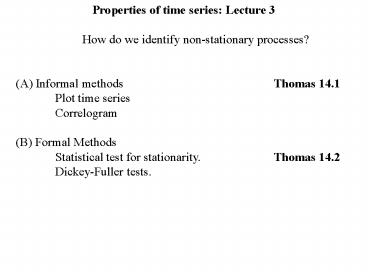How do we identify non-stationary processes? PowerPoint PPT Presentation
1 / 13
Title: How do we identify non-stationary processes?
1
Properties of time series Lecture 3
How do we identify non-stationary
processes? (A) Informal methods Thomas
14.1 Plot time series Correlogram (B) Formal
Methods Statistical test for stationarity.
Thomas 14.2 Dickey-Fuller tests.
2
Informal Procedures to identify non-stationary
processes
(1) Eye ball the data (a) Constant
mean? (b) Constant variance?
3
Informal Procedures to identify non-stationary
processes
(2) Diagnostic test - Correlogram
Correlation between 1980 and 1980 k. For
stationary process correlogram dies out
rapidly. Series has no memory. 1980 is not
related to 1985.
4
Informal Procedures to identify non-stationary
processes
(2) Diagnostic test - Correlogram For a random
walk the correlogram does not die out. High
autocorrelation for large values of k
5
Statistical Tests for stationarity Simple t-test
Set up AR(1) process with drift (a) Xt a
fXt-1 ut ut iid(0,s2)
(1) Simple approach is to estimate eqtn (1)
using OLS and examine estimated f phi Use a
t-test with null Ho f 1 (non-stationary)
against alternative Ha f lt 1 (stationary). Test
Statistic TS (f 1) / (Std. Err.(f)) reject
null hypothesis when test statistic is large
negative - 5 critical value is -1.65
6
Statistical Tests for stationarity Simple t-test
Simple t-test based on AR(1) process with drift
(a) Xt a fXt-1 ut ut iid(0,s2)
(1) Problem with simple t-test
approach (1) lagged dependent variables gt f
biased downwards in small samples (i.e. dynamic
bias) (2) When f 1, we have non-stationary
process and standard regression analysis is
invalid (i.e. non-standard distribution)
7
Dickey Fuller (DF) approach to non-stationarity
testing
Dickey and Fuller (1979) suggest we subtract Xt-1
from both sides of eqtn. (1) Xt - Xt-1 a
fXt-1 - Xt-1 ut ut iid(0,s2) ?Xt
a fXt-1 ut f f 1
(2) Use a t-test with null Ho f 0
(non-stationary or Unit Root) against
alternative Ha f lt 0 (stationary). - Large
negative test statistics reject
non-stationarity - This is know as unit root
test since in eqtn. (1) Ho f 1.
8
Dickey Fuller (DF) tests for unit root
Use t-test with a non-standard distribution
because of (1) dynamic bias in eqtn (1)
(2) non-stationary variables under null -
distribution of Dickey-Fuller test statistics
created by simulation critical value for tµ-test
are larger than normal t-test. t tau Example
Sample size of n 25 at 5 level of significance
for eqtn. (2) tµ-critical value
-3.00 t-test critical value -1.65
?pt-1 -0.007 - 0.190pt-1
(-1.05) (-1.49) f -0.190 tµ
-1.49 gt -3.00 hence unit root.
9
Augmented Dickey Fuller (ADF) test for unit root
Dickey Fuller tests assume that the residual ut
in eqtn. (2) are non-autocorrelated. Solution
incorporate lagged dependent variables. For
quarterly data add up to four lags. ?Xt a
fXt-1 ?1?Xt-1 ?2?Xt-2 ?3?Xt-3 ?4?Xt-4
ut (3) Problem arises of
differentiating between models. Use a general to
specific approach to eliminate insignificant
variables Check final parsimonious model for
autocorrelation. Check F-test for significant
variables Use Information Criteria. Trade-off
parsimony vs residual variance.
10
Incorporating time trends in ADF test for unit
root
From before some time series clearly display an
upward trend (non-stationary mean). Should
therefore incorporate trend in ADF test (i.e.
equation 3). ?Xt a ßtrend fXt-1
?1?Xt-1 ?2?Xt-2 ?3?Xt-3 ?4?Xt-4 ut
(4) It may be the case that Xt will
be stationary around a trend. Although if a trend
is not included series is non-stationary.
11
Different DF tests Summary t-type test
tt ?Xt a ßtrend fXt-1 ut (a) Ho f
0 Ha f lt 0 tµ ?Xt a fXt-1
ut (b) Ho f 0 Ha f lt 0 t ?Xt fXt-1
ut (c) Ho f 0 Ha f lt 0 Critical
values from Fuller (1976)
12
Different DF tests Summary F-type test
F3 ?Xt a ßtrend fXt-1 ut (a) Ho f
ß 0 Ha f? 0 or ß? 0 F1 ?Xt a
fXt-1 ut (b) Ho f a 0 Ha f? 0
or a? 0 Critical values from Dickey and Fuller
(1981)
13
Alternative statistical test for stationarity
One further approach is the Sargan and Bhargava
(1983) test which uses the Durbin-Watson
statistic. If Xt is regressed on a constant
alone, we then examine the residuals for serial
correlation. Serial correlation in the
residuals (long memory) will fail the DW test
and result in a low value for this test. This
test has not proven so popular.

